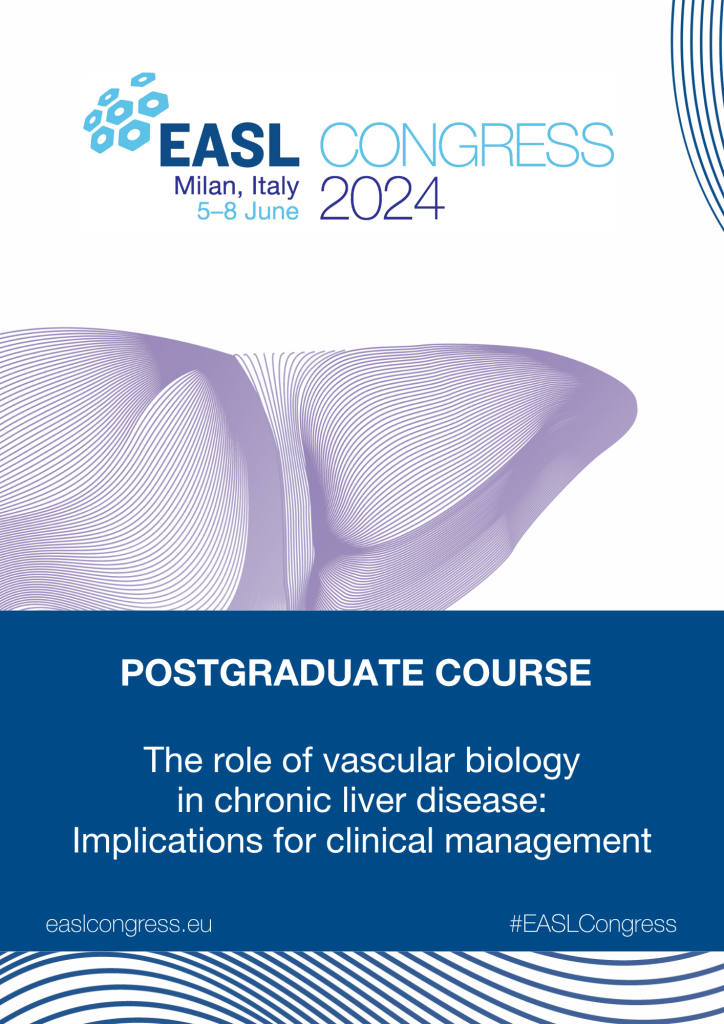Postgraduate Course
The role of vascular biology in chronic liver disease: Implications for clinical management
Welcome to this postgraduate course on the role of vascular biology in chronic liver disease. The programme is divided into 4 blocks, all approaching vascular changes that can be observed in chronic liver disease. The first two blocks focus on portal hypertension and its complication in patients without and with cirrhosis. The third block focuses on haemostasis alterations associated with cirrhosis. The final block addresses extrahepatic complications of cirrhosis due to vascular changes, namely cardiopulmonary complications and hepatorenal syndrome. All sessions will address pathophysiology as well as practical management.

Check the Syllabus!
Discover the essentials of vascular biology in chronic liver disease through our EASL Postgraduate course syllabus. Split into four blocks, each session tackles key topics like portal hypertension and haemostasis alterations. Ready to dive in? Download your copy now for practical insights and management strategies.
Organisers

Cristina Ripoll (Germany)
Cristina Ripoll is a Professor of Medicine at the Jena University Hospital in Jena, Germany. As a clinician, she routinely treats patients with liver diseases and mainly patients with cirrhosis and its complication. Her research is focused in the field of cirrhosis and its natural history, portal hypertension including hyperdynamic circulation and cardiac complications of cirrhosis. She is vice-secretary of the Baveno Cooperation: an EASL Consortium

Ton Lisman (The Netherlands)
Ton Lisman is a Professor of Experimental Surgery at the University Medical Center, Groningen, The Netherlands. He is internationally recognized for his work on biochemical and translational aspects of bleeding and thrombosis in patients with liver diseases. He is the chair of a scientific subcommittee on Hemostatic Management in Patients with Liver Diseases within the International Society on Thrombosis and Haemostasis, and co Editor-in-Chief of Journal of Thrombosis and Haemostasis.

Pierre Emmanuel Rautou (France)
Pierre-Emmanuel Rautou is a clinical specialist in Hepatology with a PhD in vascular biology (2011). He is Professor of Hepatology at Université Paris-Cité and Hôpital Beaujon (Clichy, France) since 2016. He is the head of the splanchnic hemodynamic laboratory at Beaujon Hospital (Clichy, France) since 2012. He is also leading an Inserm team dedicated to the study of the role of vessels in liver diseases, at the INSERM Unit 1149 (Paris Research Center on Inflammation). His research is focused on the role of vessels in liver diseases. Specifically, he is interested in primary vascular liver diseases, as well as in vascular involvement in common liver diseases development and complications.
Session Summaries & Learning Objectives
- Porto-sinusoidal vascular disorders: how to diagnose, how to treat?
- Medical management of portal vein thrombosis in patients without cirrhosis
- Medical management of portal vein thrombosis in patients with cirrhosis
- Interventional radiology for chronic portal vein thrombosis
This session focuses on the management of patients with vascular liver disorders. Porto-sinusoidal vascular disorder (PSVD) is a broad clinico-pathological entity, encompassing various overlapping histological patterns (nodular regenerative hyperplasia, obliterative portal venopathy, hepatoportal sclerosis, incomplete septal cirrhosis) and clinical entities (non-cirrhotic portal fibrosis, idiopathic portal hypertension or non-cirrhotic intrahepatic portal hypertension). All these entities are characterized by vascular alterations in the porto-sinusoidal region, possible development of portal hypertension, in the absence of cirrhosis and of complete portal vein thrombosis. This session will cover the clinical situation in which PSVD should be suspected, the work-up for associated conditions, diagnostic criteria, treatment and outcomes.
Portal vein thrombosis (PVT) developed in patients without and with cirrhosis have different clinical presentation, risk factors and management. This session will address recent and chronic PVT (including cavernoma), focusing on risk factors and on indication for anticoagulation, but also for more recent approaches based on interventional radiology.
Learning objectives:
- clinical situation in which PSVD should be suspected
- definition of PSVD
- treatment approach for PSVD
- risk factors for portal vein thrombosis (PVT)
- indications for anticoagulants in PVT
- indications for interventional radiology in PVT
- Paradigm shifts in portal hypertension
- Non-invasive tools for assessment of risk in patients with compensated cirrhosis
- Portal-hypertensive gastro-enteropathy and GAVE syndrome: diagnosis and management
- TIPS: what indications in 2024? (Alternative title: TIPS: where are the limits?)
This session approaches novel aspects in the management of patients with portal hypertension. Firstly, the paradigm shift in the management of portal hypertension in patients with compensated cirrhosis in whom prevention of decompensation has now become the main aim rather than the prevention of first variceal bleeding. The relevance of this paradigm shift in clinical practice as well as the areas of uncertainty will be highlighted. The use of non-invasive tools for assessment of risk of decompensation in compensated cirrhosis will be discussed including the utility of these tools in non-hepatological and/or in non-expert centers. Similarly, the use of non-invasive tools to identify low risk patients will also be discussed.
Portal hypertensive gastroenteropathy and gastric vascular ectasia share some common aspects but remain essentially different, especially regarding management, so that it is important to establish an adequate diagnosis, including exclusion of other gastric diseases. Both entities may cause anemia, which can be due to a number of causes in patients with cirrhosis. Novel treatment approaches will be discussed.
Learning objectives:
- concept of prevention of decompensation in patients with compensated cirrhosis
- different non-invasive tools available for risk stratification in compensated cirrhosis
- limitations of the concept of prevention of decompensation and use of non-invasive tools to evaluate the presence of clinically significant portal hypertension.
- differences between portal hypertensive gastroenteropathy and gastric vascular ectasia
- new treatment options for gastric vacular ectasia
- limit of TIPS both in patient selection and clinical indication
- Hemostasis in cirrhosis: what the clinician needs to know
- Prevention of bleeding related to invasive procedures in patients with cirrhosis
- Management of bleeding related to invasive procedures in patients with cirrhosis: tips and tricks
This session deals with prevention and management of procedural bleeding in patients with cirrhosis. Patients with liver disease frequently acquire complex alterations in their hemostatic system, as the liver is the site of synthesis of many proteins involved in hemostasis. These hemostatic alterations are apparent in routine diagnostic tests of hemostasis such as the platelet count, prothrombin time/International Normalised Ratio, and fibrinogen level. Although abnormal routine hemostasis tests suggest that patients with cirrhosis have a bleeding tendency, patients with cirrhosis actually are in a rebalanced hemostatic state due to simultaneous changes in pro- and antihemostatic drivers. Bleeding complications are common in patients with cirrhosis, but many of these bleeding complications are unrelated to hemostatic failure, but rather a consequence of portal hypertension or of mechanical injury to the vasculature. Prevention and treatment of bleeding complications in patients with cirrhosis thus frequently do not primarily involve hemostatic support. After an introductory talk on the concept of rebalanced hemostasis, management strategies for prevention of bleeding related to invasive procedures will be outlined, followed by case descriptions discussion management of bleeding related to invasive procedures.
Learning objectives:
- To describe hemostatic changes that may occur in patients with cirrhosis
- To understand the concept of rebalanced hemostasis in cirrhosis
- To describe strategies to minimize risk of procedure-related bleeding in patients with cirrhosis
- To describe strategies to treat procedure-related bleeding in patients with cirrhosis
Patients with cirrhosis are not protected from development of thrombotic diseases and frequently require anticoagulant treatment for prevention or management of thrombotic complications. Indications for anticoagulant drugs in patients with cirrhosis include prevention or treatment of deep vein thrombosis and pulmonary embolism, treatment of portal vein thrombosis, and management of atrial fibrillation. The choice, dose, and duration of anticoagulant drugs in these settings have not been firmly established for patients with cirrhosis, and these patients have been excluded from almost all clinical trials on anticoagulant drugs. This session will provide best practices based on the currently available data, and will discuss advantages and disadvantages of commonly used treatment regimens.
Learning objectives
- To understand the indications for prophylactic or therapeutic anticoagulant treatment in patients with cirrhosis
- To describe advantages and disadvantages of commonly used anticoagulant drugs in patients with cirrhosis
- To describe best practices for dose, type, and duration of anticoagulant for the various indications in the context of lack of high quality clinical data
- Portopulmonary hypertension: diagnosis and management
- Hepatopulmonary syndrome
- Heart involvement in cirrhosis: where are we now?
- Diagnosis and management of AKI-hepatorenal syndrome
Beyond the changes in the blood and the changes in the liver, cirrhosis leads to changes in the cardiovascular system, with the development of hyperdynamic circulation and cardiac alterations, vasodilation in some vascular beds and vasoconstriction in other vascular beds. This session will evaluate the complications of cirrhosis which are more closely related to these changes including pulmonary complications (portopulmonary hypertension and hepatopulmonary syndrome), cardiac complications and hepatorenal AKI.
The association of chronic liver disease with respiratory symptoms and hypoxia is well recognized. Pulmonary complications specific to chronic liver disease include hepatopulmonary syndrome (HPS), and portopulmonary hypertension (POPH). The development of portal hypertension is fundamental in the pathogenesis of each of these disorders. HPS is the most common condition, found in 5%-30% of cirrhosis patients, manifested by abnormal oxygenation due to the development of intrapulmonary vascular dilatations. The presence of HPS increases mortality and impairs quality of life, but is reversible with liver transplantation. POPH is characterized by development of pulmonary arterial hypertension in the setting of portal hypertension, and is present in around 5% of cirrhosis patients evaluated for liver transplantation. Screening for POPH in cirrhosis patients eligible for liver transplantation is critical since severe POPH is a relative contraindication for liver transplantation. Improvements in the management of POPH occurred in recent years.
Cirrhosis is known to cause alterations in the systemic haemodynamic system but also heart changes. Cardiac dysfunction associated with cirrhosis might influence decisions for TIPS and liver transplantation.
Hepatorenal syndrome (HRS) is a form of kidney dysfunction that characteristically occurs in cirrhosis. It is characterized by a marked impairment of kidney function in response to the circulatory and hemodynamic alterations that occur in advanced stages of liver cirrhosis, aggravated by systemic inflammation and bacterial translocation. The classical definitions of the types of HRS have been recently revisited and two forms of HRS have been re-defined: the acute form, referred to as acute kidney injury, HRS-AKI, and the chronic form, referred to as chronic kidney disease, HRS-CKD. HRS-AKI is one of the most severe forms of AKI in patients with cirrhosis and it consists of an abrupt impairment of kidney function, frequently triggered by an infection, appearing in the setting of advanced decompensated cirrhosis. Differential diagnosis with other causes of AKI is crucial, as HRS-AKI requires a specific treatment.
Learning objectives
- when to suspect and how to diagnose portopulmonary hypertension
- management of portopulmonary hypertension
- diagnosis and management of hepatopulmonary syndrome
- who should be screened for hepatopulmonary syndrome in the pre-transplant setting and outside of the transplant setting
- hyperdynamic circulation and cardiac contractility modulation in cirrhosis
- heart involvement in cirrhosis in the context of TIPS and transplantation
- diagnosis and management of AKI-hepatorenal syndrome


